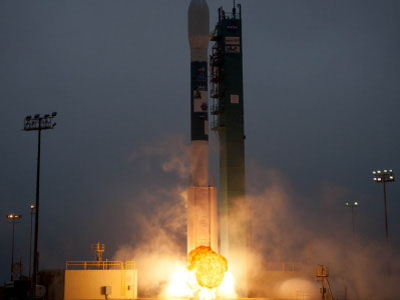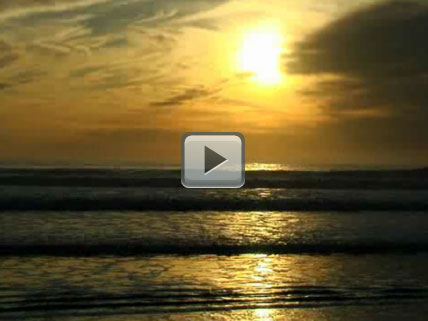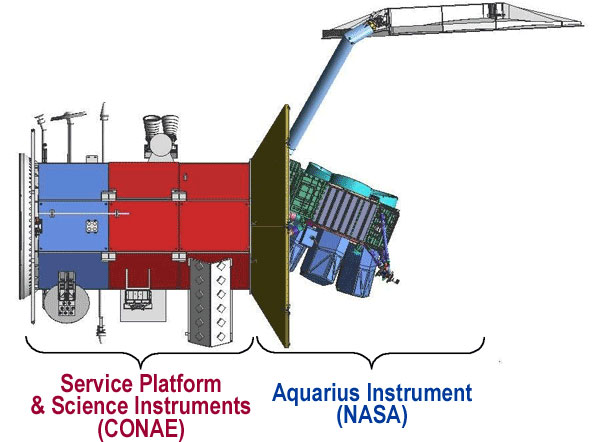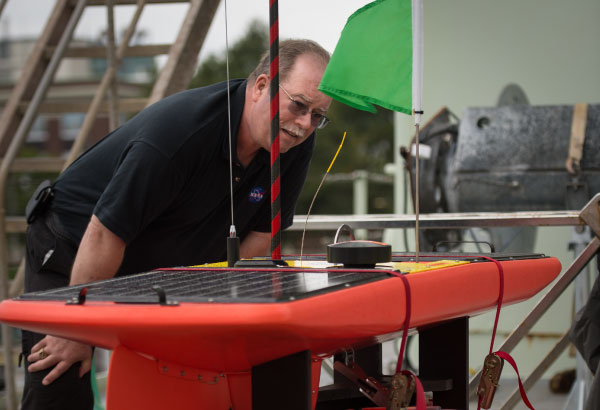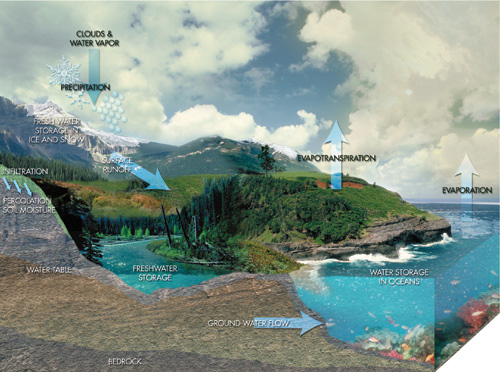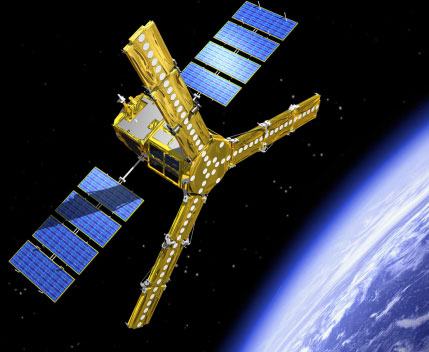Education: Technology and Collaboration
| STUDENT OUTCOMES (Learn More) |
|---|
| Explain how new technology can enhance the gathering and manipulation of oceanic data (NSES,176; NAAEE,51,52; OLS,14) |
| Explain that ocean science is interdisciplinary and requires new ways of thinking (NSES,192; OLS,14) |
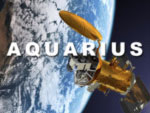 |
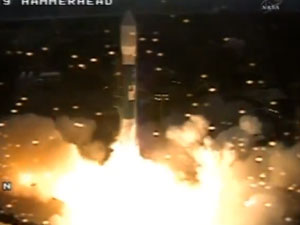 |
 Leveraging a Sensor Web Dr.Eric Lindstrom explains Leveraging a Sensor Web Dr.Eric Lindstrom explains |
How Can Technology and Collaboration Enhance Understanding of the Ocean?
NASA's Aquarius instrument, launched onboard a Delta II rocket from Vandenberg Air Force Base in California on June 10, 2011,
provided global-scale data critical to our understanding of the water cycle, ocean circulation, and climate until June 8, 2015. The
satellite flew 657 kilometers (408 miles) above Earth in an orbit that repeated every seven days. Aquarius data are used to make
monthly maps of sea surface salinity which allow scientists to resolve global salinity changes from month-to-month, season-to-season,
and year-to-year. The Aquarius/SAC-D mission is a collaboration between NASA and Argentina's space agency, Comisión Nacional de Actividades
Espaciales.Featured Movie: Aquarius and the Water Cycle
Hands-On Activities
Online Activities
Movies
- Aquarius Satellite Sensor
- ARGO Float Animation
- Monitoring Impacts By Satellite
- Satellites View Earth in a Different Light
- Viewing Ocean Change by Satellite
- Viewing Phytoplankton From Space
- Excitement About Aquarius Launch
- Getting the Full Picture
- How Aquarius Works
- Oceanographers Will "Catch Up"
Podcasts
Articles & Documents
- Aquarius Launch Details
- Aquarius/SAC-D: Sea Surface Salinity from Space
- The Aquarius/SAC-D Mission: Designed to Meet the Salinity Remote-Sensing Challenge
- What's Next for Salinity?
FAQs
- How is the Aquarius/SAC-D Mission important to everyday citizens of Argentina?
Everybody in Argentina has been following the launch of this satellite through public television and other media. The (Argentine) President was present during the transmission (of the launch). Children in schools will be receiving the information from the satellite so it's something that is not only a success or victory or something important for the scientists but it's important for the whole country. It's important to feel how proud we are of something that is sometimes very difficult to understand but that we know that somewhere in our hearts that this is a triumph of a bet that we made many years ago in Argentina. As Dr. Varotto has said, there are dreams that are worth following.Hector Timerman, Foreign Minister of Argentina.
- Why did NASA pick Argentina as its partner on this mission?
There is a history of partnership with Argentina from the earlier (i.e., SAC series) missions. Teaming and partnering with Argentina and other international organizations allows NASA to accomplish more than we can alone, just from the simple economics. Argentina has a proven track record in partnering with NASA and we were pleased and proud to be associated with Argentina for Aquarius/SAC-D. -Charles Gay
Argentina and our past collaborations with them have really helped to advance our understanding of the earth. Understanding the earth as an integrated, complex system is way too hard for any single nation, any single agency. We need to have partners who are willing to truly collaborate: not simply take orders or give orders, who have vision, who have sustained effort and are willing to attack the challenges that arise during the many years that these missions are under development. Argentina has proven time and time again, with NASA and in other ways, that the spirit of that nation - as well as the competence of (its) scientists - is there. And NASA is indeed proud to be a collaborator with Argentina and the other international collaborators on this mission. -Michael FreilichCharles Gay, Deputy Associate Administrator, NASA Science Mission Directorate and Michael Freilich, NASA Earth Science Division Director.
- What is the nature of NASA's partnership with Argentina?
In 1994, CONAE released high-level goals for Argentina's space program that included developing and applying advanced technological knowledge; enhancing economic and human resources; and fostering international cooperation. A major initiative is the SAC satellite series, the fourth of which is Aquarius/SAC-D. For each mission, NASA has provided launch operations and launch vehicles: Space Shuttle (SAC-A), Pegasus (SAC-B), and Delta II (SAC-C and SAC-D). Each satellite was conceived by CONAE and built by the technology company, INVAP, S.E., located in Bariloche. Ground control operations for each mission have been conducted in Córdoba.
SAC-A, launched by Endeavour in 1998, characterized the performance of equipment and technologies for future missions. SAC-B was designed to study solar physics and astrophysics using science instruments from CONAE, NASA, and the Italian Space Agency (Agenzia Spaziale Italiana, ASI). Launched in November 2000, SAC-C focuses on Earth observations such as monitoring Argentina's soil conditions and marine ecosystems.
Aquarius/SAC-D is the fourth satellite in this partnership. Overall mission design has been developed collaboratively between NASA and CONAE to best meet the goals of each agency while giving priority to salinity measurements. CONAE built complementary sensors to detect rain, sea ice, and wind speed, plus sea surface temperature sampling. CONAE- sponsored instruments - including sensors from the French Space Agency (Centre National d'Etudes Spatiales, CNES) and another from ASI - provide environmental data for a wide range of applications, including natural hazards, land processes, epidemiological studies, and air quality issues.
- Who is using the data collected by the Aquarius satellite and for what purpose?
At the moment, it's just being used by salinity scientists trying to understand the measurement itself. It's not quite ready for prime time yet but the reason it's flying is to understand the water cycle on the planet, among other things. In this warming world that we have, the oceans are warming, the atmosphere's warming, there's the idea that the water cycle on the planet will accelerate, there'll be more moisture in the atmosphere, more precipitation, more cycling of water through the system. And the ocean can be kind of integrated gauge for that - changes in salinity can indicate changes in evaporation and precipitation over the ocean.
In fact, if you look back over all the measurements that have been made from ships over the last 50 years and you map the changes in salinity you actually find that most of the saltier places in the ocean surface have gotten saltier and the fresher places have gotten fresher, which is exactly the fingerprint that you would think to see in an acceleration of the water cycle. So as Aquarius is coming along ocean scientists are trying to diagnose if this is really true, that there is an acceleration. We have to act like a doctor doing diagnostics on a human, we have to rule out other diseases so what we're trying to do with salinity here is rule out that it's not ocean processes fooling us to make it look like an acceleration of the water cycle. Want to read more from Eric's interview? Click here.Eric Lindstrom, Program Scientist in the Science Mission Directorate at NASA Headquarters in Oceans and Climate Change, Pod Academy, March 22, 2012.
- Do you have plans to share data between the two groups (SMOS and Aquarius)?
Absolutely. The two groups have been working in concert from the very beginning of the development of both missions. We participated in each other's science team meetings. I sat on the SMOS Science Advisory Group for about seven or eight years and we've been sharing information, algorithms, approaches to problems, things like that. There's been a great deal of communication between the two groups and we sort of see each other as one team supporting two missions in a lot of ways.Gary Lagerloef, Aquarius Principal Investigator.
- What was the reason the (Aquarius) satellite was initially built?
The mission was conceived with the primary objective to measure the ocean salinity field and the overarching scientific purpose of measuring ocean salinity is to study the interaction between the global water cycle, ocean circulation and climate variability. The global water cycle is rainfall, evaporation off the sea surface, river runoff, freezing of sea ice, melting of ice caps, all of those things that affect where fresh water is in the climate system and how it moves around. In terms of evaporation on earth, 85% comes off of the ocean. So if you look out your window and see clouds, odds are that 85% that the moisture in those clouds was evaporated off the sea surface (as opposed to off a land area). About 78% of the moisture that falls from the sky and back onto earth's surface lands on the ocean. -Gary Lagerloef
So more than 3/4 of the global water cycle is just the exchange of water between the ocean and the atmosphere. Now that said, we don't really know much about how that affects the ocean. We know it governs the broad-scale patterns of ocean salinity but how small changes in rainfall and evaporation affect the sea surface and how it affects ocean circulation are still largely unknown. That's the essence of what we want to investigate with Aquarius by mapping those variations in sea surface salinity, relating them to rainfall data that we collect from satellites, relating them to ocean temperature data that we collect from satellites, and relating it to ocean circulation data that we collect from satellites. So, in a way, Aquarius is filling in a "missing piece" of information that we really need to completely understand the role of the ocean in regulating climate and interacting with the atmosphere. That's the reason why we built Aquarius. -Gary Lagerloef
I would just like to add that it's what we call a "Pathfinder Mission" so it has the objectives of demonstrating the technology to measure salinity and then applying the salinity measurements to understanding of ocean dynamics, weather and climate, and the water cycle. -David Le VineGary Lagerloef, Aquarius Principal Investigator and David Le Vine, Deputy Principal Investigator in How Do We Cover the Globe with Aquarius Data? NASA's Aquarius Studies Our Salty Seas Webinar, January 17, 2012 (Session 2).
- Can you explain "brightness temperature"?
What we're measuring is natural radiation from the ocean surface. Everything has energy because it's not at absolute zero temperature and thus gives off radiation. An example of that is night vision. The military is able to see people at night not because they look at light but because they look at infrared radiation. The people are giving off energy at lots of frequencies. One of those (frequencies) is slightly below the optical and is called "infrared" and we use night vision to see that.
Another example of natural radiation is the heating of your electric stove. You turn on the burner, it warms up, and it glows red because it has gotten more energy and the added energy changes its frequency distribution. Now because it's so hot, it actually gives off more energy in the optical frequencies that our eyes are sensitive to. But it is also putting off radiation at all frequencies. So if we looked at it with night vision, then it would be overwhelmingly bright. And if you looked at it in the microwave frequency range (e.g., 1.41 GigaHertz, GHz like the Aquarius instrument measures), it would also look very bright. So it's giving off energy.
We talk about that energy as an equivalent temperature. So you can say that if the temperature is higher, there is more energy and if the temperature is lower, then there is less energy. The scale isn't so important because it depends on the frequency (e.g., the same temperature scale wouldn't work for the night vision scale at the infrared frequencies). But we have a scale called "Brightness Temperature" that is measuring the amount of energy that's being given off by the ocean surface at a fixed temperature.
So in the graph above right (click image to enlarge), go along the horizontal axis and stop at a sea surface temperature (SST) equal to 20 degrees Celsius (see blue box). If you go up to the blue line labeled "12 psu" (practical salinity units, psu), you'll see a purple arrow. If you read across to the vertical axis (i.e., follow the purple dashed line to the left), you see that lower salinity water gives off higher energy because the Brightness Temperature is about 104. At that same SST of 20 degrees Celsius, higher salinity water (see red arrow at 42 psu), gives of relatively lower energy (i.e., follow the red dashed line to Brightness Temperature on the vertical axis at about 88).
Aquarius has a very precise instrument that tells us how much energy is coming off the ocean surface and we express that as a "Brightness temperature". If the brightness temperature is higher, then the seawater is fresher (i.e., less salty; see pruple arrow / dashed line above). If the brightness temperature is lower, then the seawater has more salt (i.e., red arrow / dashed line). The graph shown at right was published in 1977. So an important new area of research is to develop a set of curves that are very carefully calibrated so we know exactly what energy corresponds to what salinity. And the instrument we use is very precise and makes these measurements accurately and consistently.David Le Vine, Deputy Principal Investigator in How Do We Cover the Globe with Aquarius Data? NASA's Aquarius Studies Our Salty Seas Webinar, January 17, 2012 (Session 2).
- The European SMOS mission has been trying to measure ocean salinity over a year. The mission has had issues as a result of radio frequency interference (RFI), not just soil moisture but over the oceans as well and no doubt you're going to encounter that experience too. Your thoughts on Aquarius and RFI?
That's a really good question. There are a couple of things to say about the SMOS mission and how it differs from Aquarius. First of all, SMOS stands for Soil Moisture & Ocean Salinity; it's a dual science mission. The primary science drivers for how that mission was designed were focused on measuring soil moisture. That's why the SM comes before the OS in the name of the mission. And it was always viewed as a kind of an experiment to see how well we could do salinity with it because the design is not idealized for ocean salinity. What we did differently with Aquarius was really focused on ocean salinity and what the measurement requirements were there in terms of accuracy, calibration, stability, and spatial and temporal resolution that we thought were the key science objectives.
So, the other factor is that SMOS employs a thinned aperture, phased ray design which is much more difficult to calibrate than Aquarius is going to be and so they're running into some of those problems. With regard to the radio frequency interference issue that you mentioned - that has plagued SMOS. They've done a lot of work on dealing with some of the emitters, particularly in northern Europe. Aquarius actually anticipated this problem and one of the other technological factors that went into the design of the Aquarius instrument was that we have actually tested and built an RFI filter using measurements that we've taken from rooftops and other places to see what the characteristics of that radio interference would be. So we built a filter into the processor - it hasn't been tested from space yet - but we think we'll have sort of a leg up on that problem once we get on orbit.Gary Lagerloef, Aquarius Principal Investigator.

